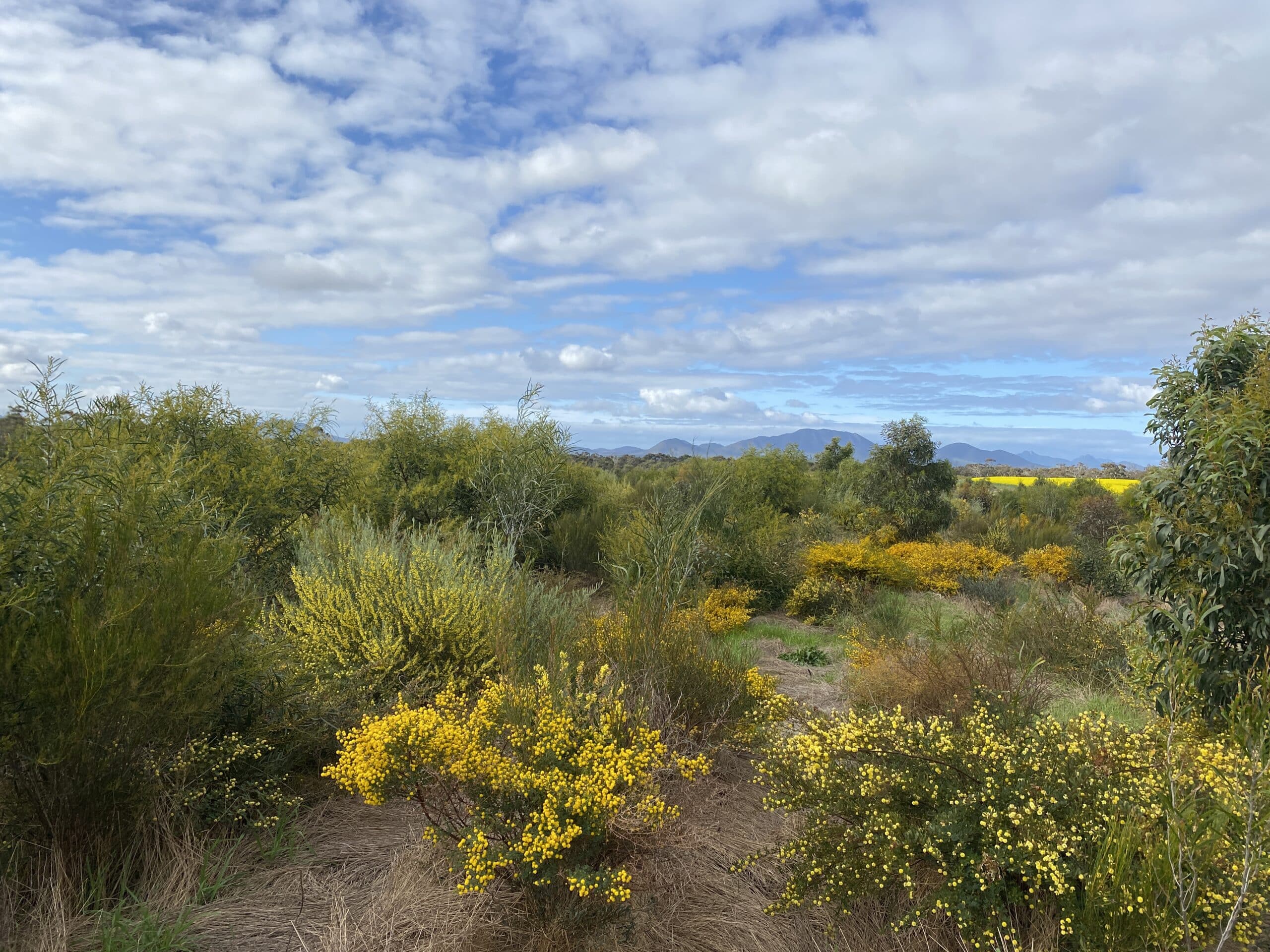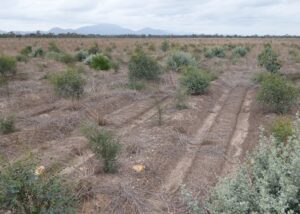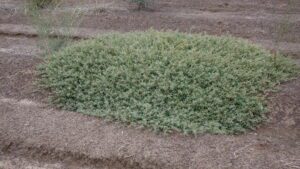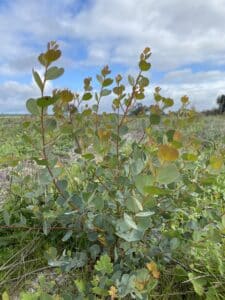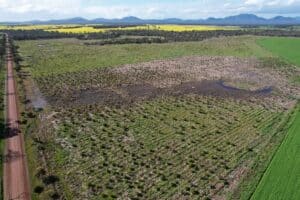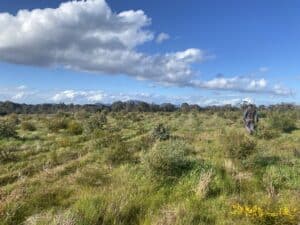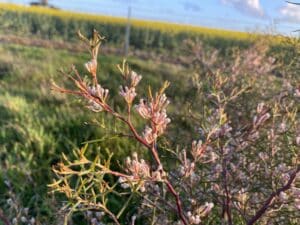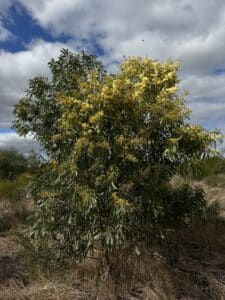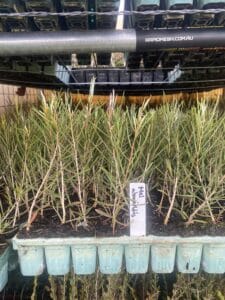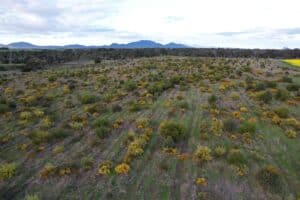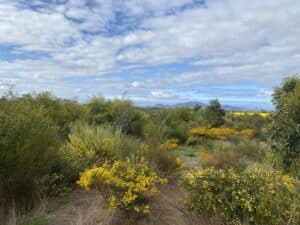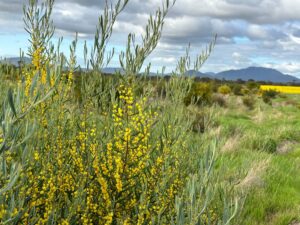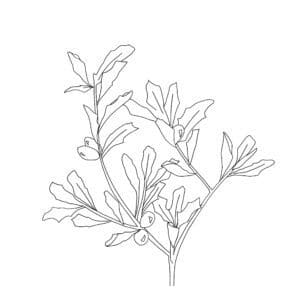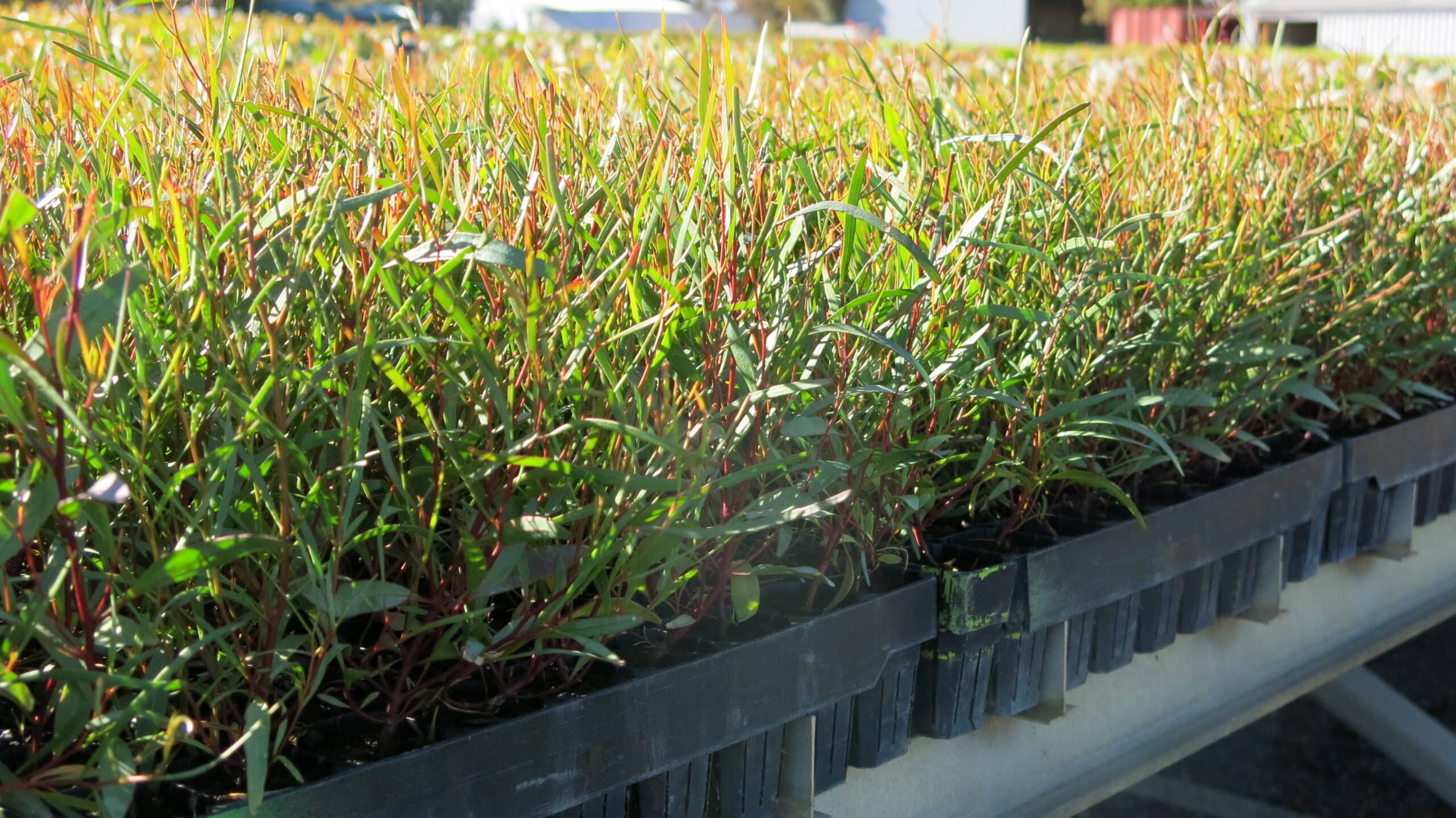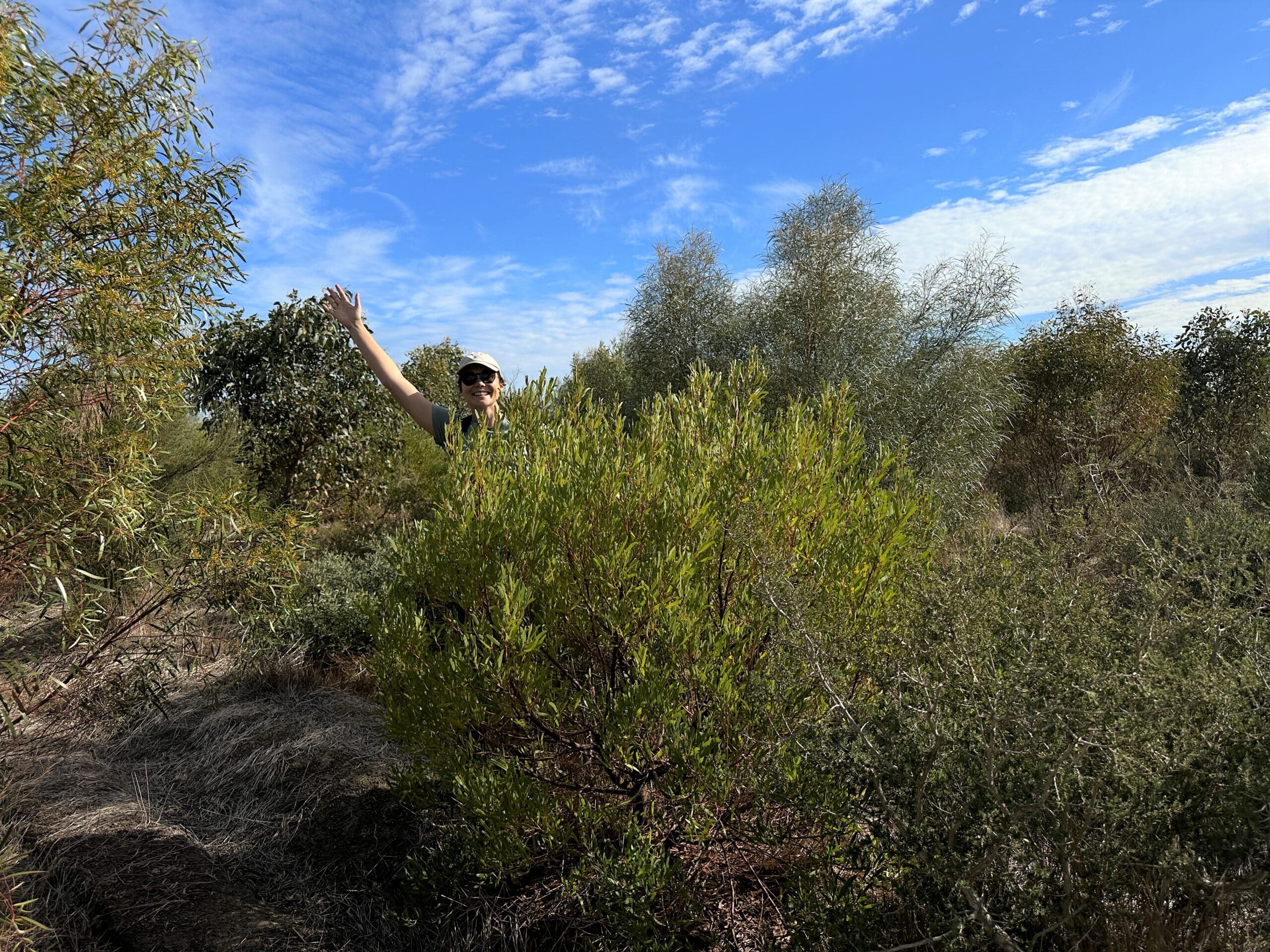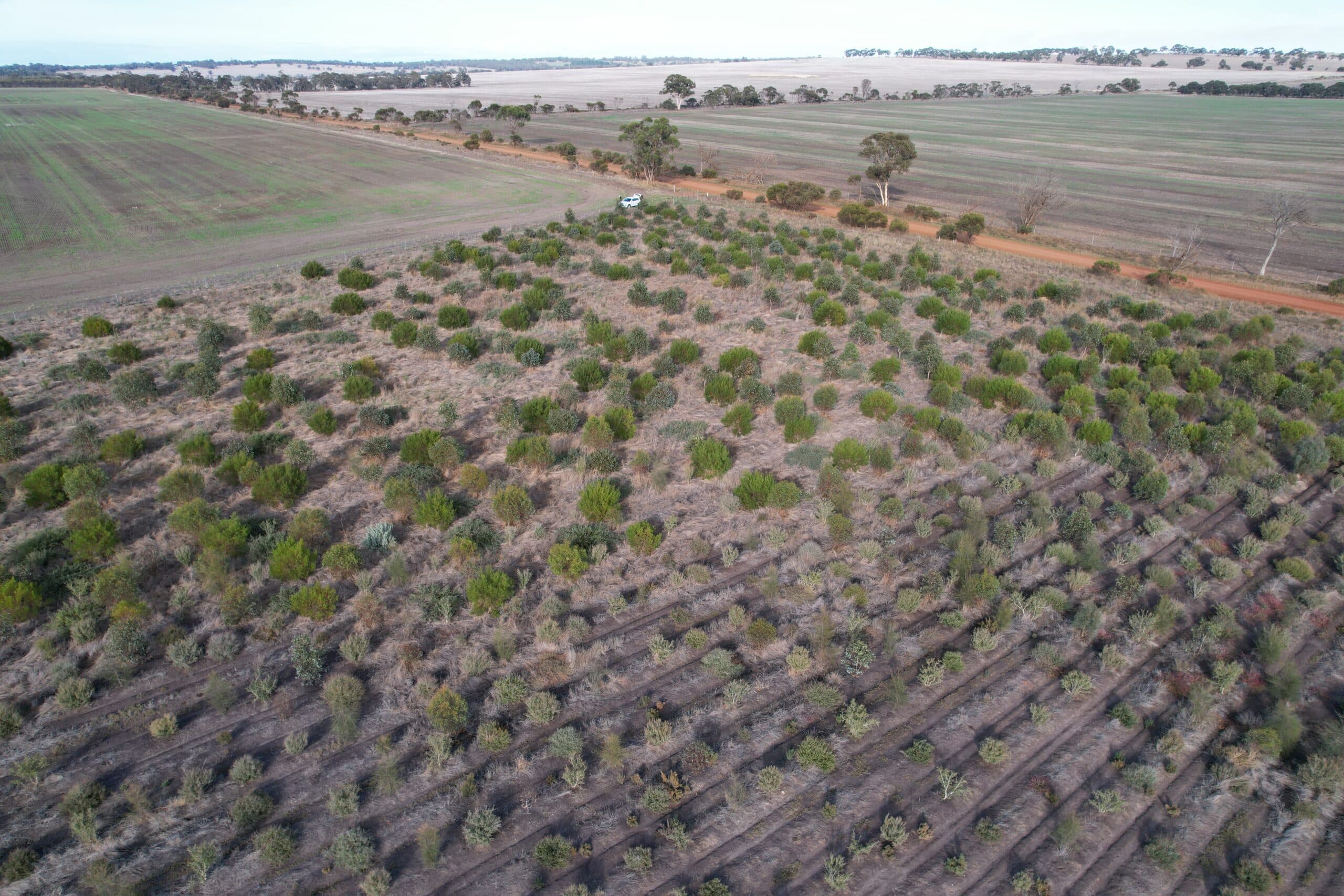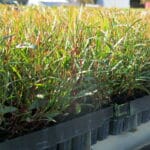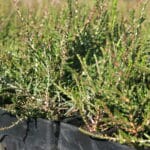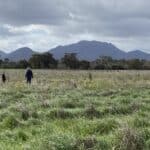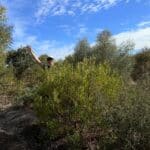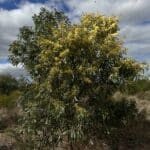![Landscape at sunset with rolling mountains in the background]()
Part of the 65 hectare area identified for planting (Photo: Justin Jonson, Threshold Environmental).
![Lines ripped in a paddock ready for trees to be planted with mountain range in the background]()
Lines ripped ready for planting against the backdrop of the Stirling Ranges (Photo: Justin Jonson, Threshold Environmental).
![Paddock with lines ripped ready for planting. Rainbow in the background.]()
Lines ripped ready for planting (Photo: Justin Jonson, Threshold Environmental).
![seeds organise and spread across a black sheet on a table]()
Native seed being dried post-heat treatment. (Photo: Justin Jonson, Threshold Environmental).
![Man holding a tray of native Australian seeds]()
A tray of Acacia acuminata (‘Jam Wattle’) seeds being cleaned (Photo: Justin Jonson, Threshold Environmental).
![Extreme close up of native Australian seeds]()
Close up of Acacia cyclops (‘Coastal wattle’) seeds post-scarification. (Photo: Justin Jonson, Threshold Environmental).
![Marianne (Parnell's Nursery) alongside some of the salt-tolerant seedlings ready to be planted.]()
Marianne (Parnell’s Nursery) alongside some of the salt-tolerant seedlings ready to be planted.
![Trays of Eucaluptus sargentii ('Salt River Gum') seedlings grown-out at Parnell's Nursery ready for planting.]()
Trays of Eucaluptus sargentii (‘Salt River Gum’) seedlings grown-out at Parnell’s Nursery ready for planting.
![Various species of salt tolerant seedlings in trays on table]()
Various species of salt tolerant seedlings.
![A tray of Melaleuca thyoides ('Salt Lake Honey-Myrtle') seedlings ready to be planted.]()
A tray of Melaleuca thyoides (‘Salt Lake Honey-Myrtle’) seedlings ready to be planted.
![People standing in and between planting around ready to plant]()
The team using pottiputkis (hand-held planting devices) to plant seedlings across the site (Photo: Justin Jonson, Threshold Environmental).
![Two men posing with planting buckets and devices.]()
Josh and Jamie from Threshold Environmental on planting day (Photo: Justin Jonson, Threshold Environmental).
![Rows of juvenile Australian tree species in a tree planting project with mountain range in the background]()
Part of the Saltland Carbon planting area showing positive germination and survival rates one-year on from planting (Photo: Justin Jonson, Threshold Environmental).
![Woman kneeling in planting area writing on a piece on paper]()
Kai from Threshold Environmental plotting quadrats in the Saltland Carbon planting area (Photo: Justin Jonson, Threshold Environmental).
![A thriving Atriplex nummularia ('Old Man Saltbush') in the Saltland Carbon area.]()
A thriving Atriplex nummularia (‘Old Man Saltbush’) in the Saltland Carbon area (Photo: Justin Jonson, Threshold Environmental).
![A low lying pale green shrub with red berries]()
A thriving Atriplex semibaccata (‘Australian Saltbush’) in the Saltland Carbon area (Photo: Justin Jonson, Threshold Environmental).
![A young Eucalyptus seedling emerging from the soil with small pebbles around the base]()
A Eucalyptus wandoo (‘White Gum’) germinated from direct seeding in the Biodiverse Carbon planting area (Photo: Justin Jonson, Threshold Environmental).
![A field with rows of planting lines and four wooden stakes marking out a square]()
A monitoring plot in the Biodiverse Carbon planting area (Photo: Justin Jonson, Threshold Environmental).
![Acacia microbotrya ('Manna Wattle')]()
Despite the weeds, an Acacia microbotrya (‘Manna Wattle’) seedling in the Biodiverse Sandalwood planting area growing well (Photo: Justin Jonson, Threshold Environmental).
![A monitoring plot measured out with a tape measure]()
A monitoring plot in the Biodiverse Sandalwood planting area (Photo: Justin Jonson, Threshold Environmental).
![An Acacia myrtifolia ('Myrtle Wattle') seedling]()
An Acacia myrtifolia (‘Myrtle Wattle’) seedling emerging in the Biodiverse Sandalwood planting area (Photo: Justin Jonson, Threshold Environmental).
![Woman and man standing next to each other in planting area]()
Louise (CPOZ) and George (Landholder) in part of the Biodiverse Carbon planting area. The team visited to discuss the project’s progress as well as future plans.
![A thriving Eucalyptus decipiens ('Redheart') spotted during the site visit.]()
A thriving Eucalyptus decipiens (‘Redheart’) spotted during the site visit.
![Two people walking in a field with mountain ranges and trees in the background]()
Jess (CPOZ) and George (Landholder) en route to one of the planting areas in the shadow of the Stirling Ranges.
![Close up of an Acacia pulchella goadbyi.]()
Close up of an Acacia pulchella goadbyi.
![Woman squatting down next to little seedlings growing in planting rows]()
Jess (CPOZ) checking out the progress of part of the Biodiverse Carbon area.
![A Regelia cymbifolia seedling that has emerged from direct seeding.]()
A Regelia cymbifolia seedling that has emerged from direct seeding in the Biodiverse Carbon planting area.
![Two people sitting in the front seats of a car driving on a dirt road]()
Driving across the farm to visit the different planting areas.
![A thriving Atriplex nummularia ('Old Man Saltbush')]()
A thriving Atriplex nummularia (‘Old Man Saltbush’) in the Biodiverse Carbon planting area.
![Drone shot of established plants in planting rows]()
Cranbrook site two years post-planting, with areas of high soil salinity visible.
![Trees growing in planting rows]()
Justin Jonson (Threshold Environmental) checking out plant growth and progress across the site.
![Thriving Banksia grandis ("Bull banksia").]()
Thriving Banksia grandis (“Bull banksia”).
![Flowering Hakea lissocarpha ("Honey bush").]()
Flowering Hakea lissocarpha (“Honey bush”).
![Flowering Acacia pulchella ("Prickly moses").]()
Flowering Acacia pulchella (“Prickly moses”).
![Hakea cucullata ("Hood-leaved hakea") beginning to flower.]()
Hakea cucullata (“Hood-leaved hakea”) beginning to flower.
![Woman standing next to a Eucalyptus tree with the Stirling Ranges visible in the background.]()
Jess (CPOZ) standing next to a Eucalyptus tree with the Stirling Ranges visible in the background.
![Angled down drone image of trees growing in planting rows with afternoon sun shining down on the trees.]()
Cranbrook site in the afternoon sun.
![Atriplex and other salt-tolerant plants growing in planting rows with weeds in between and mountain range in background.]()
Atriplex and other salt-tolerant plants in the Cranbrook saltland site.
![Woman using a measuring stick to measuring an Acacia cyclops.]()
Liv (CPOZ) measuring an impressive Acacia cyclops.
![Established plants growing in planting rows]()
Planting rows in the Saltland Carbon area.
![Close up of a flowering and fruiting Eucalyptus]()
Close up of a flowering and fruiting Eucalyptus occidentalis (‘Flat-topped yate’).
![Woman peaking out from behind an Acacia cyclops.]()
Jess (CPOZ) peaking out from behind an Acacia cyclops.
![Drone shot of established planting rows in the Saltland Carbon area.]()
Drone shot of established planting rows in the Saltland Carbon area.
![A tall flowering Acacia microbotrya ('Manna wattle').]()
A tall flowering Acacia microbotrya (‘Manna wattle’).
![close up shot of an Acacia pulchella]()
Flowering Acacia pulchella (“Prickly moses”).
![Native western Australian plants growing in planting rows]()
Very well established Saltbush and Eucalyptus’s tree in planting rows.
![close up shot of melaleuca atroviridis seedling]()
Melaleuca atroviridis seedlings in seedling trays ready to be planted.
![Angled down drone image of trees growing in planting rows with mountain range in background.]()
Cranbrook site in spring 2023 during infill planting.
![Cranbrook biodiverse carbon planting site]()
Cranbrook biodiverse carbon planting site.
![Cranbrook planting site with tree growth]()
Flowering Acacia cyclops (“coastal wattle”).
